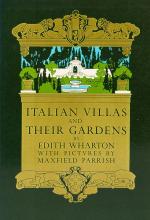Wharton, Italian Villas and their Gardens.
Italian Villas and their Gardens.
Facsimile / Reprint of the original 1904 first edition. New York, Da Capo Press, No date (1976). 18 cm x 25 cm. XXII, 270 pages. Original softcover. Very good condition with only very minor signs of external wear. Corners slightly bumped. [The Classical America Series in Art and Architecture]
Includes the following essays: Introduction / Florentine Villas / Sienese Villas / Roman villas / Villas Near Rome: Caprarola and Lante, Villa d’Este, Frascati / Genoese Villas / Lombard Villas / Villas of Venetia.
″Struck by the magnificence of the Italian countryside from the time of her first sojourn there, our ranking novelist and lady of letters of the early 1900s—a renowned connoisseur—joined forces with the foremost illustrator of the time to celebrate a subject that was dear to them both: the incomparable villas and gardens of Italy. Edith Wharton draws on three centuries of knowledge written in four languages and covers some eighty villas and sixty garden architects. She describes the remarkable splendor of the villas for readers who have never seen them, and leads the reader through her discoveries of why the great houses and grounds create an effect of such profound calm and resolution.Their impact is not merely a matter of ancient statues or splashing fountains—impressive as these may be. Rather, the unique harmony stems from the spirit of the architects’ and the designers’ art: that delicate blending of man’s work and the variations of nature to achieve a sense of flawless concord. Her success in describing the Villa D’Este, the Villa Medici, and others, is enhanced and vivified by the breathtaking, full-color paintings of Maxfield Parrish.In his introductory essay, Henry Hope Reed, president of Classical America, places Italian Villas and Their Gardens in the context of American garden design at the turn of the century. Edith Wharton’s thesis, that there is much value to be learned from the traditional Italian garden, helped to shape the American landscape of the era. In conveying the message, Maxfield Parrish proved a worthy acolyte. Thomas S. Hayes, who is president of the Edith Whatron Restoration, Inc., tells in his essay how the Italian model guided her in designing the garden of her famous country house, the Mount, at Lenox, Massachusetts.” (Amazon)
- Keywords: Architecture · Architecture – Rare · Garden Collection – Ann Geneva · Garden Design – Collection · Garden Design – Rare · Italian Culture · Italian History · Italian History – Rare · Library & Collection Building
- Language: English
- ISBN: 0306800489
- Inventory Number: 72400AB
© 2024 Inanna Rare Books Ltd. | Powered by HESCOM-Software













